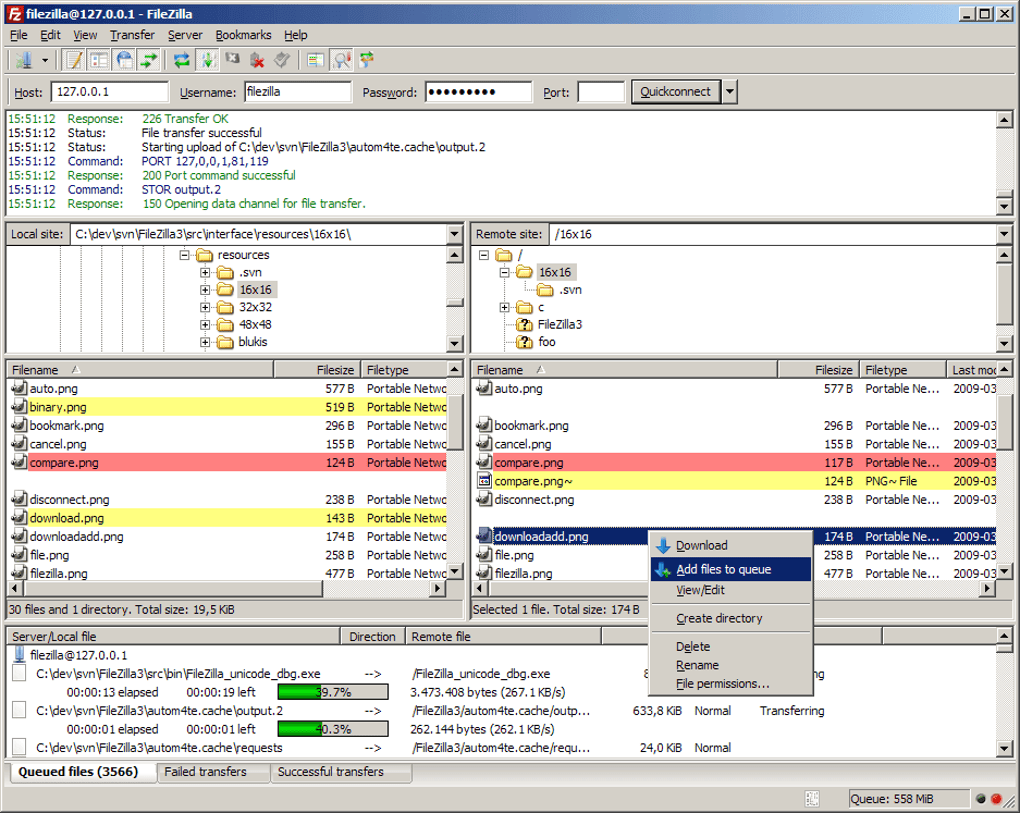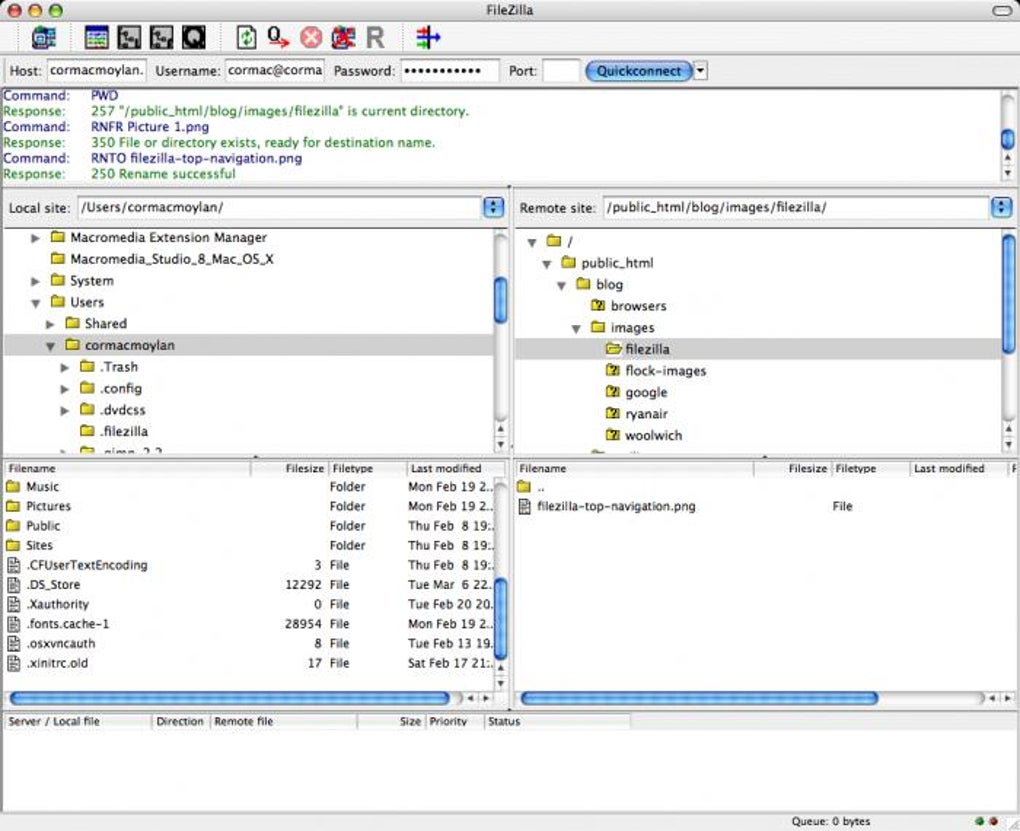While the developer is fixing the problem, try using an older version. If you need the previous version of FileZilla, check out the app's version history which includes all versions available to download. Download prior versions of FileZilla for Mac. All previous versions of FileZilla are virus-free and free to download. WinSCP is one of the most powerful and easy to use FTP client for Windows users. Sep 02, 2020 FileZilla is an FTP program for file uploading and downloading to and from your FTP site, server, or host. The program lets you transfer files and navigate among folders, Web sites, and your. FileZilla Pro manages all of your transfers no matter how many files are in your source directory, it is heavily optimized for speed and you can also adjust the pace of your transfers at will. To learn more about what FileZilla Pro features, read below. FileZilla Pro in 30 seconds, Video #90 - YouTube.
FileZilla on Mac will make many things easier for you, whether it is file transferring or sending videos. If you are eager to run an organized relocation of files and documents in the background but without any interruption during the business hours, then FileZilla download on Mac is what you need because it is eligible to transfer the files with excellent speed and with absolutely no disruption.
Overview of FileZilla for Mac:
FileZilla is one of the most confidential and a reliable FTP agent that relocates and moves files, this transferring between client and a server is done without any distraction.
What does it do?
The super-high-speed of FileZilla enables transferring multiple files with an unimaginable efficiency. When it comes to comfort, then FileZilla is the one that is truly unbeatable, its expertise with a desktop-based app of FTP is fantastic.
Is FileZilla installation on Mac is free? – Download FileZilla for Mac
Well most of the features of FileZilla are undeniably free, but some apps will cost you, but trust me it worth it.
Features of Using FileZilla for Mac:
There are some handful of incredible features FileZilla offers, take a quick look below:
- FileZilla is capable of transferring files in SFTP, FTP, coded and encrypted FTP, for instance, SFTP and FTPS
- FileZilla efficiently supports IPv6
- The process of transmitting can remain to continue and pause
- For using frequently, there is handy access to Bookmarks
- For downloading and uploading you can drag and drop
- It is capable of file searching on the server distantly
- It comes with a well-synchronized directory surfing
How to use FileZilla on Mac?
Let’s get to know how you can use it, take a look:
Get FileZilla download on Mac
The first step is to get it to download on Mac, you need to download the correct version, and after downloading now, you need to double-click + install ‘FileZilla Client’ on your system (computer).
Configuring a connection
The configuration of a connection is required on a DivX FTP server, for this open the FileZilla client and hit the “Open Site Manager.”
Give a name to the new connection.
Filezilla Client Mac 10.6
Name this new site connection and provide the info for the host, user name along with the password and confirmation method. By hitting OK, you will be able to connect with FTP servers, so click the Site name
Pick up your desired file:
Now it’s time to select your desired file for uploading, so pick it up and click it, you will be able to see the button of Upload, hit it. You can also drag your selected file to a window that will be located on the right side. Now you have done the uploading of files to DivX FTP server.

FileZilla for Mac has made it so convenient to pass-on and resumes larger size files because of the rocket speed it has. If your data is of 4GB or even more extensive than that, then FileZilla download on Mac will make it so easy for you to transfer it or resume it. It is one of the coolest features of it.
Related Posts:
FileZilla is a free client software that allows its users to connect a local PC with an online server in order to exchange data. Uploads and downloads are carried out via the network protocol FTP (file transfer protocol), SFTP (SSH file transfer protocol), or FTPS (FTP over SSL/TLS). The program is licensed under GPL (GNU General Public License) and is available for download for Windows, Mac OS X, and Linux on the file hosting platform, SourceForge. Download links to the current version are found on FileZilla’s website.
In this tutorial, we’ll show you how to use FileZilla and give you an overview of its functions–from installation to data transfer.
Do you want to save or transfer data? Then rent a secure FTP hosting from IONOS. Secure transfers via SSH and SSL/TLS, as well as daily back-ups are included.
Installing the client software
FileZilla’s installation can vary greatly depending on which software is supporting it. Essentially, all that needs to be done is for the desired software packet to be downloaded from the internet and then started up on a locally connected computer.
- Windows: to install FileZilla for Windows, login with admin rights, run the installation file with the ending, .exe, and follow the set-up instructions

- Mac OS: installing FileZilla on a Mac requires OS-X version 10.7 or higher. The software is easily installed by double clicking on the unzipped software package
- GNU/Linux: for an easy installation of GNU/Linux, use your distributor’s package manager
User interfaces with window layouts
FileZilla presents the following interface in order to exchange files between your locally connected computer and a server.
The client software’s user interface is divided into 6 areas, which have been marked with different colors for clarity.
- Toolbar (purple): provides varying functions

- QuickConnect bar (red): this section is for the connection to the server
- Message protocol (green): displays messages about transfers and the connection
- Local directory (pink): shows files and directories on the locally connected PC
- Server directory (yellow): shows files and directories on the server
- Transfer queue (orange): lists files that are to be transferred as well as files that have already been transferred
Setting up a FileZilla server connection
Establishing a server connection is easy with the help of the Quickconnect function located under the menu bar.
Enter the appropriate login data in the corresponding boxes located in the Quickconnect bar. This consists of a server name, user name, and a password. The server name (host) refers to the domain under which the computer is available over the internet. The IP address can also be used as an alternative at this point.

Leave the ‘port’ box empty if there is no specific login data for this parameter. For those wishing to set up a secure connection via FTPS or SFTP for the data transfer, add the following network protocols to beginning of the server name:
sftp://examplename.com
ftps://examplename.com
Server names without such prefixes result in unencrypted FTP connections.
The connection set-up’s status is displayed in the message protocol located below the Quickconnect bar:
Connection set-up via FileZilla site manager
Alternatively, you can set up a connection via the program’s site manager. Select the first button on the tool bar, ‘site manager…’.
The server manager then opens its own dialog box where you can then add new servers. Name the entry for the server set-up and confirm this with the enter button. Now enter your server’s login data in the corresponding tab, ‘General’. Select the connection type, ‘Normal’, and close the dialog box by clicking ‘Connect’. FileZilla then establishes a connection to your server.
In order to make the setup of such connections easier in the future, FileZilla offers users the possibility to save login data, including passwords, into the site manager. But this can be a risk as connection data is stored on locally connected computers in plain text. Unfortunately, there’s no function available for storing this information in an encrypted form.
Transferring data
In order to transfer data from your locally connected computer to the server, select the file or directory (located in the local directory tree) you wish to send and move it via drag and drop into the target directory located on the server. As soon as you’ve determined its destination, the file then appears in the transfer queue. Transferring files or directories from the server onto the local computer follows this pattern as well.
Filezilla For Mac 10.4
In addition to the drag and drop feature, you can also upload and download items through a context menu, which appears with a right click. This function also allows you to manage (i.e. create or delete) files and directories on the server.
Should any of your actions when uploading and downloading lead to a file being overwritten, then FileZilla automatically opens a dialog window where you’re able to make decisions regarding the file in question. Here, you can choose to allow the file to be overwritten, skipped, or have its name changed.
Comparing directories
FileZilla has provided a function for comparing directories so that you’re able to keep an overview of the data being exchanged between your locally connected computer and the online server. Use the ‘Directory comparisons’ option in the toolbar to manage this task. Once the directory comparison has been activated, FileZilla then highlights the file differences in various colors, all of which are associated with different situations. The color coded statuses are broken down as follows:
- Files with no highlighting: the file on the locally connected computer and on the server are identical
- Yellow highlighted file: files are located either on the locally connected computer or on the server, but not on both.
- Green highlighted files: files are located on the locally connected computer, but vary from one another in terms of their alteration dates
- Red highlighted files: files are located on the locally connected computer and server, but vary from one another in terms of their file sizes
Filezilla For Mac Client Permissions
